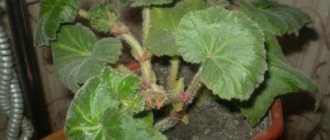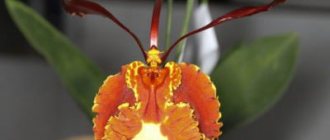When is a transplant needed?
The plant really needs replanting. As the roots grow, they gradually fill the container where it lives. There are several cases when a transplant is required:
- roots appear from the drainage holes and extend beyond the pot;
- the plant is sick, depressed, and loses its decorative properties. The leaves turn yellow, fungal infections are detected;
- the appearance of pests in the soil, including the possibility of egg laying;
- The old pot has become unusable.
Begonia in bloom
In some cases, the plant has not yet reached large size, but the pot was found to be completely filled with roots. This means that the time has come to change the container. Begonias that have not yet mastered the entire capacity and are healthy are not transplanted.
There is another case when replacing the pot is necessary. The flower is provided with another pot and fresh soil. The begonia plant needs replanting after purchase. It is not recommended to rush through the procedure, but in a store-bought container the plant will sooner or later wither.
In what cases is a transplant required?
Guests from tropical latitudes are periodically transplanted.
- It is advisable to do this immediately after purchase, since the substrate in which it grows contains an excess of fertilizers that prolong and promote flowering. Flower growers will not use them after purchase, as a result of which the unreplanted plant will soon die.
- Replanting is needed as soon as roots are noticed emerging from the drainage holes of the pot.
How often to replant begonia?
The transfer of the plant from the old container is planned in early spring. This choice of time of year is the most correct, because growth processes are just beginning to intensify. At this time, the indoor flower will endure the procedure and recover with minimal losses.
Important ! With excessive growth of the root system, the risk of injury increases. This situation cannot be allowed to happen.
Experienced gardeners believe that changing the container and soil should be made an annual event. This is due to the fact that the soil becomes depleted over time. The plant is given the opportunity to restore its composition, replenishing it with the necessary nutrients. It is better not to forget about the regularity of the procedure in order to avoid death.
It's time to replant the begonia
There is another important question: is it possible to replant begonia that is currently blooming? This should be done only after the flowering process is complete. Then the procedure will be safe, otherwise the flowers will begin to fall off. There is a possibility that the plant will lose its decorative qualities, taking on a sickly appearance.
How to choose a pot and soil?
A competent choice of container and soil will be the key to health for begonias. This is the most important factor in the question of how to replant begonia. You need to make sure you have everything you need before the transplant event. The list of components is as follows:
- a suitable pot should not be overly large. Young begonias are transplanted into containers that are 3 or 4 cm larger in diameter than the previous ones;
- The material of the container is important. They prefer ceramics, although plastic is also suitable for creating the necessary conditions;
- When deciding how to plant begonia, for each part they take containers 2 or 3 cm smaller than the previous one. When separating the rosettes, the original plant is left in its original container. Technological pots have a size of 6 by 6 cm;
- soil mixture of suitable quality. This is a mixture of peat, turf, humus and ordinary soil in equal proportions;
- drainage as the basis for comfort. They take expanded clay, crushed stone, pieces of foam plastic and other materials.
Having prepared the listed components of the process, they begin to transfer the plant to a new place of residence.
Begonia in a new pot
Important ! The shape of the next pot should not create additional difficulties. For example, if the edges are curved inward, it is easy for pests to hide there.
Blooming begonia is not replanted
Soil disinfection
There is one nuance in the question of how to properly transplant begonia at home step by step. It is important to disinfect the soil, which will ensure the absence of pests that can attack the plant from soil infested with larvae. It is convenient to use an ordinary microwave oven for the procedure.
Preparation: soil and pot
When choosing a container for begonias, give preference to plastic pots. This option will prevent rotting of the root system and stagnation of moisture. Ceramic and clay pots with high trays work well. Thanks to them, excess water during irrigation will not remain in the ground.
Young and already rooted cuttings are planted in pots with a diameter of 3 cm, and older plants - 4-5 cm. When replanting, use a container that is at least 1/3 larger than the previous one. Place drainage (broken shards, expanded clay, brick fragments) at the bottom of the container. The next layer is charcoal.
A loose and breathable substrate is suitable for begonias. To replant young plants, combine soil and peat in equal proportions, and for adults - soil, peat and sand. In such a substrate, the plant will begin to develop a good root system and beautiful green mass. Before planting begonias, water the soil mixture with warm water. Read more about choosing a flowerpot and caring for begonias in a pot here.
Transplant methods
Two methods are possible: complete and partial transplantation. The first case refers to the purchase of a new plant or when diseases or pests are detected. Actions should be carried out as follows:
- Expanded clay is poured onto the bottom of the prepared pot;
- by pouring charcoal in the next layer, it will be possible to prevent rotting of the roots;
- drainage is covered with 2 cm of soil;
- Begonia can be easily removed from the previous container if you water it, turn it over or tilt it, and tap it a little;
- shake off the old soil. It won't hurt to wash the roots in a weak solution of potassium permanganate. Damaged and dead parts are removed;
- The plant is placed in a new container, holding the stem, and covered with fresh soil. The root collar is not buried.
All that remains is to lightly compact the soil. Although when watering, shrinkage will occur by itself, after which you just need to add more soil. The transfer method is applied to a healthy plant into a larger container. This is a gentle mode. Having moved the begonia along with the earthen lump into another pot, add fresh soil to the free space. This method only partially renews the soil.
Is it possible to replant flowering begonia?
It is not recommended to replant flowering begonia in the standard way with pruning and disinfection of the root system. If there is a need to move the crop to a new container, then such an operation can be performed by transferring the plant into a flowerpot while maintaining the integrity of the earthen coma. After this, the soil is moistened, the crop is installed in a shaded place, away from sunlight. To continue the flowering process, the plant needs fertilizing. Enrichment of the soil with nutrients is not carried out immediately; the first time this can be done 2-3 weeks after transplanting.
Care after replanting a plant
When properly caring for begonia, you need to take into account its light-loving nature. Active growth will be observed under intense but diffuse lighting. Immediately after transplantation, the pot is placed on a western or eastern window. Other rules are set out in the following list:
- exclusion of drafts;
- the temperature cannot be too low: from + 15 in winter and + 18-20 degrees in summer. Its stability and absence of changes are important;
- if diseases are detected, treatment is started immediately, otherwise the plant may be lost;
- in winter additional lighting will be required;
- Watering is done correctly, to which the flower crop responds well. Use only soft water, and remove excess water from the pan in a timely manner;
- Feeding applied on time (2 times a week) will help strengthen the immune system against diseases. The store has a range of fertilizers for begonias or indoor flowers. The dose is reduced by half.
The watering scheme requires special attention. Its frequency in summer should be at least 2 times a week, and in hot weather - every day. With the onset of autumn, by October the soil is moistened as its top layer dries. In winter, the frequency does not exceed twice a week. From March the amount of moisture increases. It is better not to spray the plant; unhealthy spots may appear. Maintain humidity by placing the pot on wet peat or pebbles.
Replanting after purchase
The rules for replacing the container with which the plant was purchased are similar to those outlined above. Planting can take place immediately. But it is not recommended to rush too much. The best solution is to wait for two weeks or a month. And if flowering is observed, the procedure is prohibited until it ends. The container size is usually left the same.
Typical mistakes during transplantation
An unsuccessful event can lead to the death of the plant. The following errors are indicated:
- The size of the new container is incorrectly selected. If the size is too large, the soil may turn sour and the roots will deteriorate;
- the soil is heavy, its permeability is insufficient, there is a lot of peat. All this provokes stagnation of water. Too much acidity (over 6.0) is also harmful;
- the root collar was buried, although it should have been left in its original position. Then the plant will rot.
Attention ! Good drainage is very important.
Features of the begonia root system
There are several types of begonias available for sale. They differ not only in decorative properties, but also in their root system.
The most common is tuberous begonia, the varieties of which are mainly flowering. The petioles of the plant grow from a round or flat-round tuber, reminiscent of a potato tuber, but smaller in size. Small roots grow from its bottom.
Decorative deciduous species have a rhizomatous and branched root system. The rhizome consists of many small shoots. The root plant has several roots growing from the base of the petiole.
Any root system of begonias is in the top layer of soil. They should be handled with care so as not to break the delicate roots.
Begonia - home care and important features
If you have a begonia growing, caring for it at home will not be too different from caring for other flowers, but there are some subtleties - this touch-me-not likes to come into contact with other plants, so if possible, provide it with a separate windowsill or move it away from neighbors .
Caring for flowering begonias involves providing the plant with good lighting - it always needs a lot of light, but especially during the flowering period. Decorative deciduous varieties can get by with less light.
In summer, protect begonia from direct sunlight to avoid burns - the ideal temperature in the warm season is +20 °C...+25 °C, in winter - about +18 °C.
The flower needs high air humidity, but it is not advisable to spray the leaves - water often causes dark spots on begonias, so it is better to place the pot in a tray with damp expanded clay. Water the begonia with warm water; moisture should not stagnate in the container. Watering is required when the top layer of soil has dried a centimeter, but in winter it is watered less often, and tuberous begonia species are not moistened at all and are kept in peat soil.
It is best to feed begonia with a complex liquid product twice a month - nitrogen fertilizers are not suitable for flowering plants, but phosphorus fertilizers are necessary, while deciduous plants, on the contrary, need nitrogen.
Determining the need to transplant begonias
Young plants develop slowly. It will take more than a year for them to grow luxuriantly. But this does not mean that they do not need a transplant.
Reasons why begonia requires a new place of residence:
- pests - unwanted residents may be found in the soil;
- diseases - the plant is depressed and has lost its attractive appearance;
- damage to the previous flower pot;
- a new plant was purchased.
Important! If roots appear in the drainage holes of the pot in which the begonia is grown, this is a signal for immediate replanting. The same applies to those cases when the roots have completely filled the container.
How to choose the right container
Begonias have shallow roots. Therefore, it does not need deep planting containers. For planting, choose wide pots, up to 15 cm high.
Reference. You should pay attention to the age of the flower. For young ones and those grown from cuttings, a diameter of the upper edge of 5–6 cm is sufficient, for tubers and older ones – up to 8–10 cm.
To plant begonias, it is better to purchase ceramic or plastic flower pots with drainage holes in the base. Water will not stagnate in such flower beds, which will help prevent rotting of the root system.
It is believed that a newly purchased plant should be replanted in a pot of the same volume in which it was sold. For overgrown begonias, the roots of which have occupied the entire volume of the old pot, an increase in the volume of the new one by 30% is required. If young plants taken from the mother bush are replanted, a pot 2–3 cm smaller in volume than they grew before will be sufficient for them.
What to do if begonia wilts after transplantation
The wilting of begonias after transplantation is due to improper implementation of the procedure for moving the plant to a new container. This can occur by deepening the root collar of the crop into the soil. This part of the plant should be flush with the soil surface. Also, wilting of begonia can be caused by a dry or highly moistened nutrient substrate. In the first case, the process occurs through a lack of moisture, in the second - as a result of rotting of the root system of the plant.
What to do
A problem is easier to prevent than to solve. Here are the main preventive actions:
- carry out the transplant according to the described rules;
- after transplanting, place the flower in a shaded place;
- Watering should be moderate, but the soil should always be kept moist.
- Use pots with drainage holes and a tray.
If everything was done correctly and leaf wilting could not be prevented, then the problem can be solved as follows. Fallen plants are covered with a plastic bag, which will create a greenhouse effect. It is advisable to cut off drying leaves with a twisted petiole (they only take away strength and interfere with the restoration of the crop). If necessary, you can immediately cut off several of the most damaged shoots.
If all the leaves of a begonia have drooped and the stem has fallen, then to restore the flower it is necessary to carry out the following procedures. To begin with, we free the root part from the nutrient substrate, trim the small roots and tear off the leaves. We soak the root system in settled water for a day, after which we plant the plant in a mixture of perlite and peat. Cover the above-ground part with a plastic bag. Please note that watering the crop during the recovery period should be minimal. The liquid is applied in small doses away from the flower trunk.
Preparing for transplant
Even for a novice gardener, the question of how to properly transplant a begonia is not easy. If you follow the step-by-step requirements, it will not be difficult at all.
- The selected pots are thoroughly washed with soapy water and dried.
- A layer of drainage material is poured into the prepared pot. This can be expanded clay, small pebbles, stones, crushed foam.
- Pour crushed activated carbon onto the drainage. Then fill 1/2 full with the selected soil mixture and water.
- Water the soil in a pot with begonia.
- Carefully release the plant from the previous pot. Excess old soil is removed.
- Treat the roots with a weak solution of potassium permanganate. Can be soaked for 30 minutes.
- Detected torn and rotten roots are carefully removed with pruning shears treated with vodka or potassium permanganate.
- The roots are washed with clean water and dried.
- The treated flower is placed in a new pot and covered with new soil around it. Under no circumstances should the root collar be buried. Leave 1-2 cm to the edge of the pot. After a few weeks, if necessary, soil can be added around.
When is the best time to do this?
If desired, you can replant begonia with a shoot at any time of the year . Experienced flower growers try to do this in the spring months. At this time, all its forces are activated, as a result of which adaptation to the new place will be faster and it will soon bloom. Frequency of plant replanting:
- young - annually;
- old - once every two years.
Preparations for transplantation begin in advance. A couple of days before day “X,” the begonia is thoroughly watered and a new soil mixture is prepared. Following these steps will ensure an easy and hassle-free transplant.
Transplant methods
The question may arise of how to replant begonia if it is a cutting or a young plant.
- If the flower has a main stem, cuttings can be used.
- Creeping begonias and those with pubescent leaves can be propagated by part of the leaf.
- Flowering hybrids are propagated by seeds.
- Bush begonias - by dividing the rhizome.
- Tuberous species are planted so that the buds are above the surface of the ground.
Photo
You can visually familiarize yourself with how to properly plant a plant at home in the photo below:
Care after replanting a plant
After replanting, the plant is shaded for several days and not watered until the top layer of soil dries out a little. After this, the plant can be placed in a well-lit place, but in such a way as to avoid direct sunlight.
To create optimal ambient humidity, water containers are placed next to the newly planted plant. Begonias cannot be sprayed, especially leafy types.
Begonia prefers an even temperature of +20°C. Drafts should also be excluded; when ventilating the room, it should be isolated from the flow of cold air.
Subsequently, the flower is watered twice a week, reducing watering in the fall, starting in October. During the winter months, watering should be minimal, just enough to moisten the soil. It is better to feed flowers 2 times a month with complex mineral fertilizers with microelements, according to the attached instructions.
At the end of the growing season, it is better to put the roots or tubers in peat and not water them until spring.
The main errors are:
- Inappropriate flower pot. Too big is not suitable. The begonia will grow in it for a very long time and will not bloom soon.
- Dense soil composition. The soil must allow oxygen to pass through and be loose. Otherwise, the water will begin to stagnate and the soil will become acidic. In this case, the plant will be depressed and may die.
- If you deepen the root collar, rotting will begin in this place. The begonia will die.
Following the rules of replanting will allow you to admire this flower plant outside in the garden or on the window of your house for many years. Timely operation will ensure proper development and lush flowering.
Source











